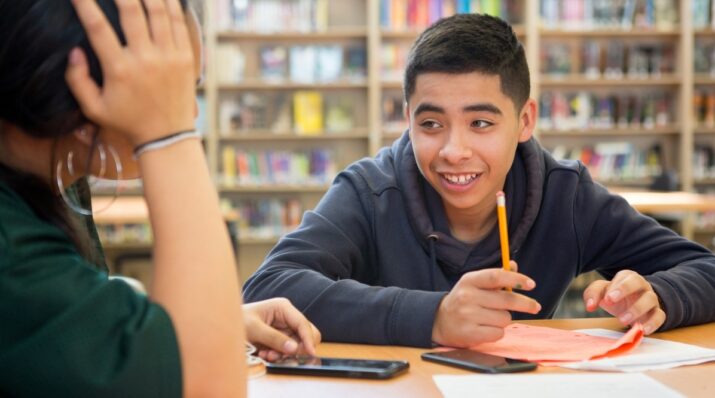New Designs for School
Three Essential Ingredients for a Student-Centered Classroom
Topics

We’ve all had the experience of truly purposeful, authentic learning and know how valuable it is. Educators are taking the best of what we know about learning, student support, effective instruction, and interpersonal skill-building to completely reimagine schools so that students experience that kind of purposeful learning all day, every day.
When these three ingredients are present in a truly student-centered lesson, students are most likely to learn both academic content and productive habits of mind.
In my years as a teacher, I’ve encountered my fair share of lesson- and unit-planning templates. They come in all shapes and sizes: Understanding by Design, the 5Es, HyperDocs, I Do/We Do/You Do, etc. The list goes on and on.
At best, these templates push teachers to plan learning activities that are engaging, efficient, and effective. At worst, they create unnecessary paperwork and headaches for overworked teachers. Some teachers like using them; others don’t. Teachers, like students, are infinitely diverse. One size will never fit all.
As a teacher I’ve come to realize that, templates aside, any truly student-centered lesson requires three key ingredients. When these elements are present, I’ve found that students are most likely to learn both academic content and productive habits of mind. The essential ingredients are:
1. Something Worth Doing.
When I first started teaching, I rarely thought about what I taught. I was given content to teach, and it would be on the test, so I tried to teach it. My students, of course, saw right through this. They asked me constantly, “Why do we have to learn this?” I tried to answer, but my answers often felt insincere. I realized then: the value of everything students learn should be always be apparent to them. They don’t have time to do things “just in case” they’ll need them later, or “because they’ll be on the test.” As teachers, we must strive to give them assignments that are truly worth doing—then our students will truly want to do them!
(This doesn’t mean, by the way, that students always need to learn things that are immediately applicable to them—that’s preferable, but sometimes made impossible by required standards. What it does mean is that every assignment must have a clear purpose, both to the teacher and to the student. If students are doing work without clear purpose, they’re wasting their time!)
2. Useful Resources.
Learning is an active process: it requires students to go out and chase knowledge for themselves. If students don’t take an active role in their own educations—if they are expected to learn by simply sitting and listening—then they aren’t developing the skills they’ll need to keep learning, in college and throughout their lives.
What teachers need to provide, therefore, is not only direct instruction and support, but high-quality resources that students can use to teach themselves. Videos, graphic organizers, self-assessment rubrics, they all work! (As I suggested above, I’ve never been a stickler for particular formats or templates—I like creating videos myself with Screencast-o-Matic and Edpuzzle, but I’ll often pull videos off the internet if I find ones I like.) What matters is that my students can use these resources to guide their own learning.
3. A System for Tracking Progress.
The first two elements, I’ll admit, can cause a bit of chaos. Truly meaningful student assignments often take longer than a single class to complete, and students who teach themselves will inevitably move at different paces. That’s okay, and it’s part of learning! What a real student-centered classroom requires, therefore, is an organized system that makes it clear to both learners and teachers (a) where each student is in the curriculum, and (b) what each student should do next.
Such systems, too, can take a variety of forms. Some teachers like charts on the wall; some prefer color-coded lists or spreadsheets; and others use designated platforms like MasteryTrack. Once again, it’s not the form that matters; it’s the philosophy. When students know exactly what they need to do next, they’re generally eager to move on; when teachers know exactly what each student is learning, they have the data they need to provide effective, targeted support. That’s when real learning will occur.
In the training work I do with teachers, I often give the following hypothetical: “Imagine you were going to be out sick for a week, and you knew that a random person, with no teacher training whatsoever, would substitute for you. What structures would you put in place to ensure that your students learn as much as possible?”
When I ask this question, most teachers respond with the elements I’ve described above. “I’d give the students really interesting work,” they say, “so that my substitute wouldn’t need to motivate them.” Or, “I’d give them lots of resources, so that the substitute wouldn’t need to explain everything.” And finally, “I’d give very precise directions so that the students would know exactly what to do.”
These responses, I tell them, are brilliant. So I ask: “Why not put these structures in place every day?” Why not give students purposeful, self-directed, and clear learning experiences every day? Why not design structures that empower students to take charge of their own learning, and as a teacher, make myself available—as a particularly effective resource—to help students along? If we could design classrooms like these, would there be any limit to what our students can learn?
It isn’t easy to create a student-centered classroom like this, but it’s worth the effort. I’ve given you the key ingredients. Now, get cooking!
Photo courtesy of Allison Shelley/The Verbatim Agency for American Education: Images of Teachers and Students in Action.




